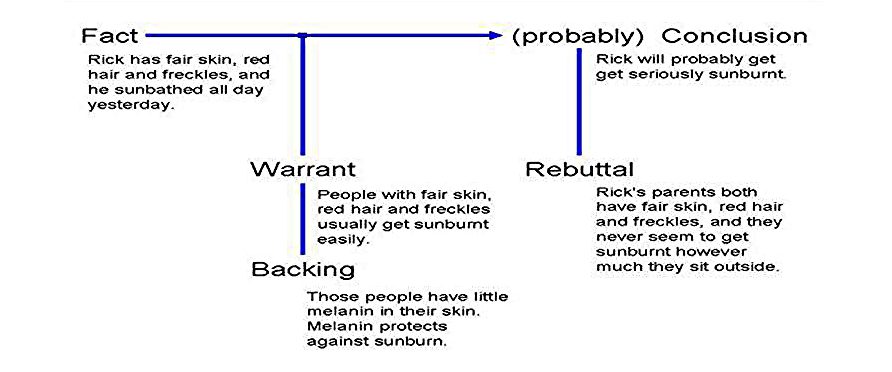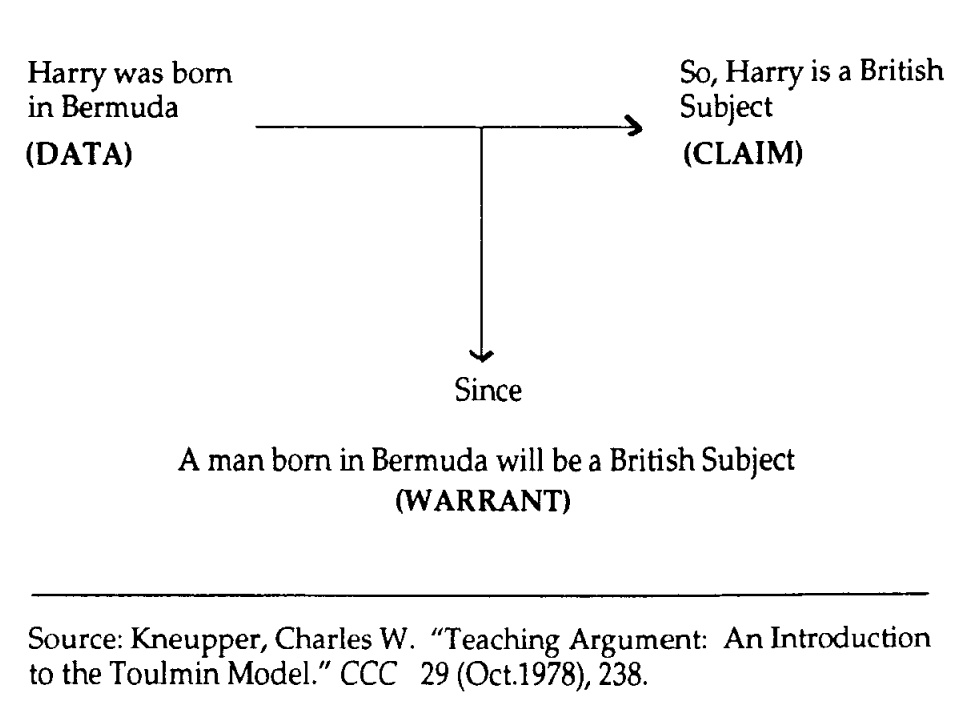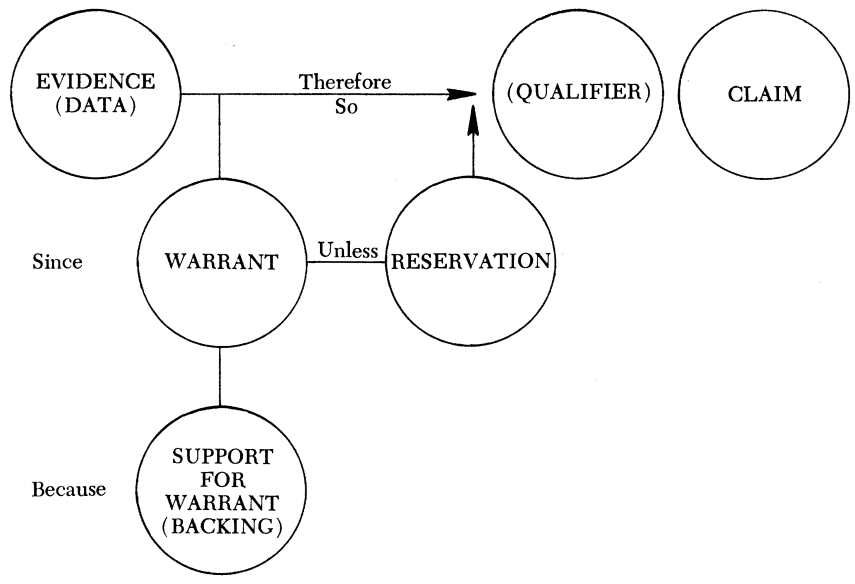Table of Contents
Collaboration, information literacy, writing process, toulmin argument.
Stephen Toulmin's model of argumentation theorizes six rhetorical moves constitute argumentation: Evidence , Warrant , Claim , Qualifier , Rebuttal, and Backing . Learn to develop clear, persuasive arguments and to critique the arguments of others. By learning this model, you'll gain the skills to construct clearer, more persuasive arguments and critically assess the arguments presented by others, enhancing your writing and analytical abilities in academic and professional settings.

Stephen Toulmin’s (1958) model of argument conceptualizes argument as a series of six rhetorical moves :
- Data, Evidence
- Counterargument, Counterclaim
- Reservation/Rebuttal

Related Concepts
Evidence ; Persuasion; Rhetorical Analysis ; Rhetorical Reasoning
Why Does Toulmin Argument Matter?
Toulmin’s model of argumentation is particularly valuable for college students because it provides a structured framework for analyzing and constructing arguments, skills that are essential across various academic disciplines and real-world situations.
By understanding Toulmin’s components—claim, evidence, warrant, backing, qualifier, and rebuttal—students can develop more coherent, persuasive arguments and critically evaluate the arguments of others. This model encourages students to think deeply about the logic and effectiveness of their argumentation, emphasizing the importance of supporting claims with solid evidence and reasoning. Additionally, familiarity with Toulmin’s model prepares students for scenarios involving critical analysis and debate, whether in writing essays, participating in discussions, or presenting research.
By mastering this model, students enhance their ability to communicate effectively, a crucial skill for academic success and professional advancement.
When should writers or speakers consider Toulmin’s model of argument?
Toulmin’s model of argument works especially well in situations where disputes are being reviewed by a third party — such as judge, an arbitrator, or evaluation committee.
Declarative knowledge of Toulmin Argument helps with
- inventing or developing your own arguments (even if you’re developing a Rogerian or Aristotelian argument )
- critiquing your arguments or the arguments of others.
Summary of Stephen Toulmin’s Model of Argument
The three essential components of argument.
Stephen Toulmin’s model of argument posits the three essential elements of an argument are
- Data (aka a Fact or Evidence)
- Warrant (which the writer, speaker, knowledge worker . . . may imply rather than explicitly state).
Toulmin’s model presumes data, matters of fact and opinion, must be supplied as evidence to support a claim. The claim focuses the discourse by explicitly stating the desired conclusion of the argument.
In turn, a warrant, the third essential component of an argument, provides the reasoning that links the data to the claim.

The example in Figure 1 demonstrates the abstract, hypothetical linking between a claim and data that a warrant provides. Prior to this link–that. people born in Bermuda are British–the claim that Harry is a British subject because he was born in Bermuda is unsubstantiated.
The 6 Elements of Successful Argument
While the argument presented in Figure 1 is a simple one, life is not always simple.
In situations where people are likely to dispute the application of a warrant to data, you may need to develop backing for your warrants. o account for the conflicting desires and assumptions of an audience, Toulmin identifies a second triad of components that may not be used:
- Reservation
- Qualification.
Charles Kneupper provides us with the following diagram of these six elements (238):

*This article is adapted from Moxley, Joseph M. “ Reinventing the Wheel or Teaching the Basics ?: College Writers ‘ Knowledge of Argumentation .” Composition. Studies 21.2 (1993): 3-15.
Kneupper, C. W. (1978). Teaching Argument: An Introduction to the Toulmin Model. College Composition and Communication , 29 (3), 237–241. https://doi.org/10.2307/356935
Moxley, Joseph M. “ Reinventing the Wheel or Teaching the Basics ?: College Writers ‘ Knowledge of Argumentation .” Composition. Studies 21.2 (1993): 3-15.
Toulmin, S. (1969). The Uses of Argument , Cambridge, England: Cambridge University Press

Brevity - Say More with Less

Clarity (in Speech and Writing)

Coherence - How to Achieve Coherence in Writing

Flow - How to Create Flow in Writing

Inclusivity - Inclusive Language

The Elements of Style - The DNA of Powerful Writing


Suggested Edits
- Please select the purpose of your message. * - Corrections, Typos, or Edits Technical Support/Problems using the site Advertising with Writing Commons Copyright Issues I am contacting you about something else
- Your full name
- Your email address *
- Page URL needing edits *
- Name This field is for validation purposes and should be left unchanged.
Other Topics:

Citation - Definition - Introduction to Citation in Academic & Professional Writing
- Joseph M. Moxley
Explore the different ways to cite sources in academic and professional writing, including in-text (Parenthetical), numerical, and note citations.

Collaboration - What is the Role of Collaboration in Academic & Professional Writing?
Collaboration refers to the act of working with others or AI to solve problems, coauthor texts, and develop products and services. Collaboration is a highly prized workplace competency in academic...

Genre may reference a type of writing, art, or musical composition; socially-agreed upon expectations about how writers and speakers should respond to particular rhetorical situations; the cultural values; the epistemological assumptions...

Grammar refers to the rules that inform how people and discourse communities use language (e.g., written or spoken English, body language, or visual language) to communicate. Learn about the rhetorical...

Information Literacy - Discerning Quality Information from Noise
Information Literacy refers to the competencies associated with locating, evaluating, using, and archiving information. In order to thrive, much less survive in a global information economy — an economy where information functions as a...

Mindset refers to a person or community’s way of feeling, thinking, and acting about a topic. The mindsets you hold, consciously or subconsciously, shape how you feel, think, and act–and...

Rhetoric: Exploring Its Definition and Impact on Modern Communication
Learn about rhetoric and rhetorical practices (e.g., rhetorical analysis, rhetorical reasoning, rhetorical situation, and rhetorical stance) so that you can strategically manage how you compose and subsequently produce a text...

Style, most simply, refers to how you say something as opposed to what you say. The style of your writing matters because audiences are unlikely to read your work or...

The Writing Process - Research on Composing
The writing process refers to everything you do in order to complete a writing project. Over the last six decades, researchers have studied and theorized about how writers go about...

Writing Studies
Writing studies refers to an interdisciplinary community of scholars and researchers who study writing. Writing studies also refers to an academic, interdisciplinary discipline – a subject of study. Students in...
Featured Articles

Academic Writing – How to Write for the Academic Community

Professional Writing – How to Write for the Professional World

Authority – How to Establish Credibility in Speech & Writing

IMAGES
VIDEO
COMMENTS
Toulmin argumentation can be diagrammed as a conclusion established, more or less, on the basis of a fact supported by a warrant (with backing), and a possible rebuttal.Toulmin Model. Chiswick Chap, CC BY-SA 3.0. Stephen Toulmin’s (1958) model of argument conceptualizes argument as a series of six rhetorical moves: Claim. Data, Evidence. Warrant.